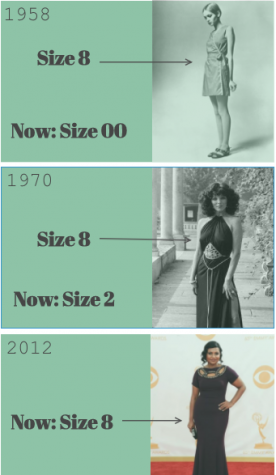All Sizes Matter
November 1, 2018
I’ve always hated shopping, ever since the day my mom and I first went to the mall where I realized I never fit into anything.
Clothes were always too big, too tight, too long. Stores became a never-ending abyss of un-flattering clothes, that I know every girl has dealt with.
As opposed to men, where it’s just pants and a shirt sizes: small, medium, large, and extra-large, women’s sizing seems impossible to understand. Well, I’m here to tell you it doesn’t make sense to you, because it DOESN’T make sense.
Women are being conned by the closeted secret that is vanity sizing, and other fundamental problems with the plus size market.
Vanity sizing, also known as size inflation, is the practice of assigning smaller sizes to articles of manufactured clothing than what the measurements represent in order to encourage sales.
Whether you realize it or not, clothing stores are fabricating new sizes to make you feel skinnier.
The problem with vanity sizing has become so extreme that a study by Time Magazine documents size 8 throughout history. The results are as follows: In 1958 a size 00 would have been a size 8 now. In the 1970’s, a size 2 would be a size 8 now. Even as recent as 1995, a size 8 now would have been a size 6 then.
Vanity sizing is promoting unhealthy body images among young women.

Stores are using toxic beauty standards of being skinny to their advantage, while also cutting out skinny people from sizes.
If size 8 has become bigger than what it actually should be, what happens to peoples whose bodies area size 8? Sizes only go down to a 00. If sizes are only getting larger, how will small people find clothes that fit?
Vanity sizing is also ethically dangerous. Statistics from Cosmopolitan state 68% of American women wear a size 14 or above, and while they are making these sizes smaller and smaller, this essentially tells women that they have to feel skinny.
There is nothing wrong with not being skinny, yet the plus size system doesn’t accurately represent what plus size women look like. A size 16 is considered plus size, yet if 68% of women are above a size 14, plus size isn’t really plus size at all.
Plus-size is normal, but manufacturers are telling women being plus size is above average. In reality, women who are actually plus size can’t find clothes that fit.
The plus size market has grown so large that separate stores have been opened dedicated to the market. This shouldn’t be a surprise because plus size is again, normal. In specialty plus size stores, and even at places like Target, anything above an XL costs more.
Stores shame plus size women. They make them believe they are not normal, so plus size clothes should not have normal prices. They hide under the excuse of “more material,” but do not make it consistent across the board because XS to XL would also be using more material yet the prices are the same.
If you are willing to let stores tell you skinny is better and that actually skinny and large people don’t exist, then so be it. The rest of us, however, will fight against the stores that use body image as a way to con more money out of women. Women just want to buy clothes at a fair price that represent their bodies, no matter what size.



